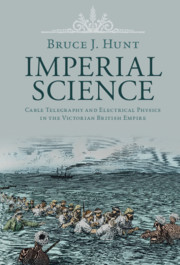Book contents
- Imperial Science
- Science in History
- Imperial Science
- Copyright page
- Contents
- Figures
- Acknowledgments
- Abbreviations
- Prologue: “An Imperial Science”
- 1 “An Ill-Understood Effect of Induction”
- 2 Wildman Whitehouse, William Thomson, and the First Atlantic Cable
- 3 Redeeming Failure
- 4 Units and Standards
- 5 The Ohm, the Speed of Light, and Maxwell’s Theory of the Electromagnetic Field
- 6 To Rule the Waves
- Epilogue Full Circle
- Bibliography
- Index
Epilogue Full Circle
Published online by Cambridge University Press: 11 December 2020
- Imperial Science
- Science in History
- Imperial Science
- Copyright page
- Contents
- Figures
- Acknowledgments
- Abbreviations
- Prologue: “An Imperial Science”
- 1 “An Ill-Understood Effect of Induction”
- 2 Wildman Whitehouse, William Thomson, and the First Atlantic Cable
- 3 Redeeming Failure
- 4 Units and Standards
- 5 The Ohm, the Speed of Light, and Maxwell’s Theory of the Electromagnetic Field
- 6 To Rule the Waves
- Epilogue Full Circle
- Bibliography
- Index
Summary
In 1902, a consortium of British imperial powers laid a string of cables across the Pacific, connecting Canada to Fiji, Australia, and New Zealand. The new cables completed the “All Red Line,” circling the globe while touching only on British-controlled territories, and set the capstone to the worldwide British cable network (Figure 7.1). That network would remain of vital strategic and economic importance for decades to come, but as the twentieth century dawned, both physics and electrical technology found themselves moving in new directions. Cable telegraphy had nourished the rise of field theory, but that theory had led in its turn to the discovery of electromagnetic waves and then to the development and promotion by Oliver Lodge, Guglielmo Marconi and others of practical systems of wireless telegraphy.
- Type
- Chapter
- Information
- Imperial ScienceCable Telegraphy and Electrical Physics in the Victorian British Empire, pp. 272 - 275Publisher: Cambridge University PressPrint publication year: 2021

